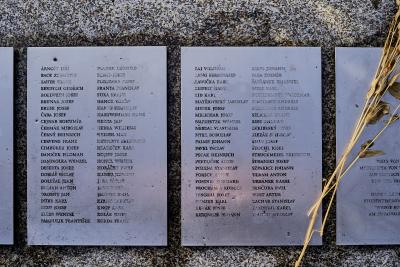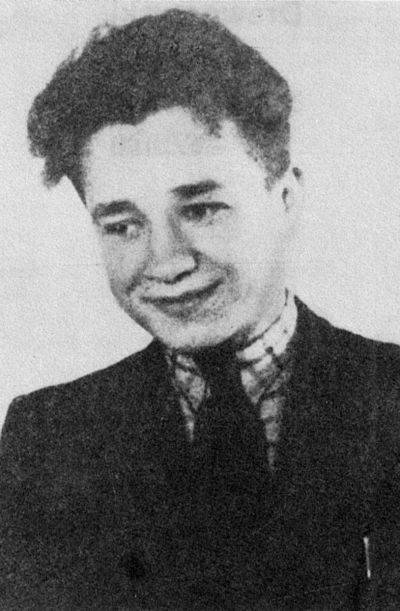Polish graves at the Perlacher Forst cemetery in Munich

The cemetery and its history
Due to Munich's steady population growth there was a shortage of free space in the city's cemeteries at the end of the 1920s. For instance, in 1929 the East Cemetery was completely overcrowded. Thereupon plans were made to build a new cemetery for up to 100,000 graves on a 100 hectare site at Schwanseestraße. The Stadelheim prison was nearby. Since there was a wide strip of land between the building and the planned cemetery, the planners took over the site. The implementation of the project was entrusted to the city council architect, Hermann Leitenstorfer. It was to be Munich's largest and most beautiful cemetery complex. A chapel was built in the middle of the complex, from which there ran radial avenues surrounded by hedges. Furthermore, trees were planted along the avenues, thereby linking the entire complex to the nearby forest that gave its name to the new cemetery.
Although the complex had not yet been completed the cemetery was opened on February 1. 1931. The chapel was not to be built until two years later. Initially workers and the poorest of the poor were buried in the cemetery. But it was not long before the National Socialists seized power and political reprisals increased. Over 1,200 people were executed in the neighbouring Stadelheim prison until 1945 (the exact number is unknown). Some of them were buried in anonymous mass graves to wipe out any reminder of the deeds. Other corpses were sent to anatomical institutes.
Stadelheim
Stadelheim prison dates back to the end of the 19th century. From 1942 onwards it was one of several places of execution used by the 'Volksgerichtshof'. Until then death sentences had been carried out in Berlin-Plötzensee: but the increasing imposition of death sentences then led to decentralisation. Stadelheim prison served as the execution site for south-eastern Germany and a part of the occupied territories. At the end of the Second World War more than four thousand urns were buried in the cemetery, most of them containing the mortal remains of the victims of the Dachau concentration camp. The cemetery was partially destroyed by an air raid on Munich at the beginning of January 1945. The radial cemetery complex was also changed when the prison was extended in the 1950s.
Groves of Honour and Memorials
After the Second World War it was decided to revive the cemetery and to set up groves of honour and memorials at the sites where victims of the Third Reich had found their final rest. The neighbourhood of Stadelheim prison turned out to be significant for the new purpose given to the cemetery. Among those executed and buried there were members of the Weiße Rose, a resistance group against National Socialism.
The victims of the Dachau concentration camp
The urns of the victims from the Dachau concentration camp had originally been buried in various Munich cemeteries after cremation in the camp, but now the city council decided to bury them in the first Grove of Honour, which was built in 1950. Among the prisoners who had died were Germans, Austrians, Czechs, Poles and people from the former Soviet Union, France and the Netherlands. Altogether 44 burial grounds, each containing 96 urns, were created. Every burial ground was given its own memorial stone. A fountain with mosaics and a Stone of Hope were erected in the centre of the complex. The grove was planted with lime trees, symbolising justice, love, peace and homeland. The number of victims on the memorial stone at the entrance amounts to 4092.
The people executed in Stadelheim
Four years later, in 1954, a second Grove of Honour was created to contain the mortal remains of the 93 people executed in Stadelheim, who had originally been buried in various places in the cemetery. The names of all the victims are engraved on the memorial stone unveiled in 1996. One of the people who found his final resting place there was Henryk Pecak, a forced labourer who was executed for listening to the BBC news in Polish. Another victim was Jan Hebda, who fled with two Poles to join the Polish military. Although they managed to cross the Swiss border, they were arrested, extradited to the German authorities. and executed in 1943. Around this time Waldemar Schidhabel, a Pole of German descent accused of "high treason", was also executed.
The victims of forced labour
In 1960 a memorial complex for forced labourers, prisoners of war and prisoners of concentration camps (displaced persons) was built. 1,192 people from 12 countries who died between 1942 and 1946 were buried there. The second largest group buried here, after Russians from the former Soviet Union, are Poles (274 graves). People from Bulgaria, Romania, Hungary, Greece, Turkey, France, Belgium and the Netherlands have also found their final resting places here. A monument has been erected in the centre of the complex. On the lawn there are stone tablets bearing the names of the deceased. The grove was planted with birch trees symbolising life and rebirth.
Polish soldiers
In 1998 the coffins of nine Polish soldiers who died after the war, (including members of the Świętokrzyska brigade), were transferred from the crypts of the Munich West cemetery to the vicinity in order to bury them in a specially created area within the memorial complex. The memorial service took place in the presence of representatives from the Polish Consulate and the Council for the Preservation of Remembrance of Battle and Martyrdom (Rada Ochrony Pamięci Walk i Męczeństwa). The following inscription was engraved in Polish on a granite plaque with the Polish eagle: Tu spoczywają żołnierze polscy zmarli w drodze do Ojczyzny. Cześć Ich pamięci(Here rest Polish soldiers who died on their way back home. Honour their memory).
Krzysztof Ruchniewicz, March 2018
Further reading:
Irene Stuiber: Hingerichtet in München-Stadelheim. Opfer nationalsozialistischer Verfolgung auf dem Friedhof am Perlacher Forst, Kulturreferat der Landeshauptstadt München, 2004.
Internet (http://polskiegroby.pl/s/cmentarz.php?osobaok=13096&cmentarzok=455): Perlacher Forst cemetery, “Stiftung Polnisch-Deutsche Aussöhnung” (accessed on 13.03.2018). It also contains a map of the cemetery and the list of the names of the Polish soldiers.
______________________
Citation:
Krzysztof Ruchniewicz: Polish graves at the Perlacher Forst cemetery in Munich, in: "Porta Polonica“ (No. 592), 14.03.2018, url: www.porta-polonica.de/en/node/592



























